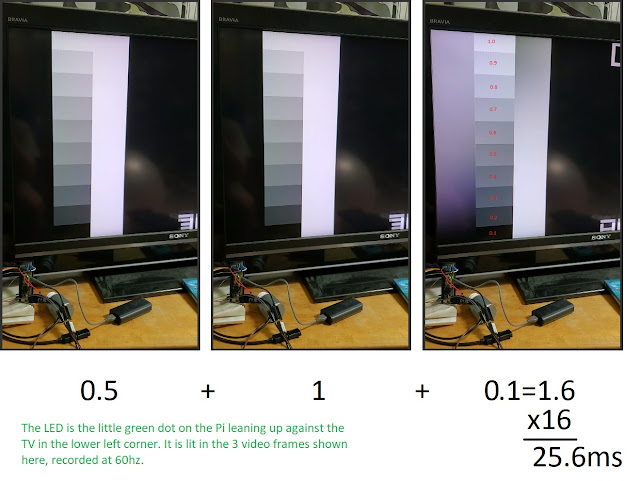piLagTesterPRO engineering sample availalbe
The piLagTesterPRO measures input lag and response time using a raspberry pi to generate the signals, and the hardware/software I've designed to measure the time-course of those signals on your display. I built it for myself first and foremost but there's been some interest in offering for sale. I'm happy to oblige as long as you understand that this is not a pretty, mass market device, though it is quite functional and in fact offers quite a lot more features than the commercial options (leo bodnar and the time sleuth).
The hardware electronics design is finished, but I'm calling it an engineering sample because the packaging might evolve a little with your feedback.
Here it is, attached to its preferred (for the moment anyway) pi: the pi zero. Yes, that's tape. I consider this a good thing; if you want to configure it into another physical package it's very easy to disassemble. It might not be much to look at splayed on the carpet, but here's the good stuff:
this photo of it in action show the real time plotting of the monitor's lag, response time, and back-light properties.
Let's see a few more details of the physical device. Here's how it plugs into the pi. With a "handy" guide as to which GPIO pins to plug it into. That's all the assembly that's really required.
There could be additional assembly if you want a fancy box for the light sensor. Personally, I decided to lean into the tape choice and use tape to attach it to the TV. This is actually really great, as it makes it very easy to monitor lag while you mess around with TV settings. Since the tape is on the bezel, there's no issue with messing up the screen. Of course, this mounting choice is up to you, and you'll have to provide your own tape anyway, since the painter's tape is only good for 10-20 removals before it looses adhesion.
Another option is to stash the sensor inside a box or bottle and hold it up to the screen:
It's really up to you, and if you come up with something extra clever do let me know. The sensor is somewhat directional, but the signal amplification is strong enough that you don't to point it exactly normal to the display surface so there's lots of room to play around.
The hardware electronics design is finished, but I'm calling it an engineering sample because the packaging might evolve a little with your feedback.
Here it is, attached to its preferred (for the moment anyway) pi: the pi zero. Yes, that's tape. I consider this a good thing; if you want to configure it into another physical package it's very easy to disassemble. It might not be much to look at splayed on the carpet, but here's the good stuff:
this photo of it in action show the real time plotting of the monitor's lag, response time, and back-light properties.
Let's see a few more details of the physical device. Here's how it plugs into the pi. With a "handy" guide as to which GPIO pins to plug it into. That's all the assembly that's really required.
There could be additional assembly if you want a fancy box for the light sensor. Personally, I decided to lean into the tape choice and use tape to attach it to the TV. This is actually really great, as it makes it very easy to monitor lag while you mess around with TV settings. Since the tape is on the bezel, there's no issue with messing up the screen. Of course, this mounting choice is up to you, and you'll have to provide your own tape anyway, since the painter's tape is only good for 10-20 removals before it looses adhesion.
Another option is to stash the sensor inside a box or bottle and hold it up to the screen:
It's really up to you, and if you come up with something extra clever do let me know. The sensor is somewhat directional, but the signal amplification is strong enough that you don't to point it exactly normal to the display surface so there's lots of room to play around.








Comments